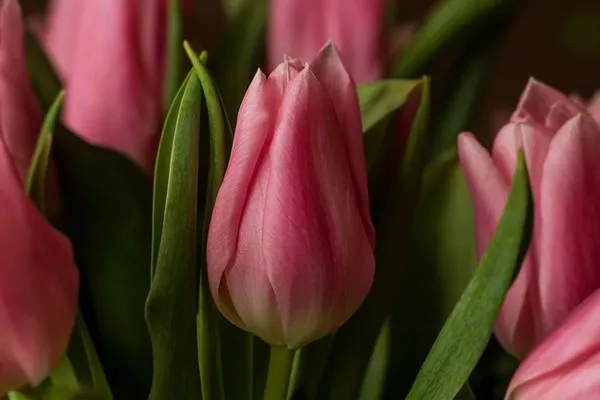In the realm of horticulture, few flowers captivate the human imagination and evoke a sense of timeless beauty as effortlessly as the tulip. Known for their vibrant hues and graceful appearance, tulips belong to the genus Tulipa, which comprises approximately 75 species and countless hybrids. Originating from Central Asia, these exquisite flowers have become synonymous with elegance and charm, adorning gardens, landscapes, and floral arrangements across the globe. This article delves into the fascinating world of tulips, exploring their history, classification, and the cultural significance that has elevated them to iconic status.
Botanical Background
Tulips, members of the Liliaceae family, are herbaceous perennials with bulbous roots. Their distinctive cup-shaped flowers boast six petal-like tepals, forming a symmetrical and visually striking bloom. Tulips are renowned for their wide range of colors, including but not limited to red, yellow, pink, purple, and white. The versatility of tulips extends to their size, with variations from miniature to towering, making them adaptable to diverse garden settings.
Species and Varieties
The genus Tulipa encompasses a diverse array of species, each with its unique characteristics. Among the notable species are Tulipa gesneriana, commonly known as the garden tulip or the common tulip, and Tulipa fosteriana, also known as the Emperor tulip. These species serve as the foundation for the vast array of cultivars and hybrids that enchant flower enthusiasts worldwide.
Hybridization has played a pivotal role in creating the myriad tulip varieties available today. With breeding programs focused on enhancing color variations, petal shapes, and overall robustness, tulip enthusiasts can choose from an extensive palette of options. Popular varieties include the Darwin Hybrid tulips, Triumph tulips, and Lily-flowered tulips, each distinguished by unique characteristics that cater to different aesthetic preferences.
Cultural Significance
Tulips have not only left an indelible mark on horticulture but have also woven themselves into the fabric of various cultures. The origins of tulips can be traced back to the Ottoman Empire in the 10th century, where they were cultivated for their aesthetic appeal and symbolic significance. Over the centuries, tulips gained popularity in Europe, particularly in the Netherlands, where the iconic Dutch tulip mania occurred in the 17th century.
The Dutch Golden Age witnessed tulips becoming a symbol of wealth and prestige, with rare and exotic varieties fetching exorbitant prices. Although the tulip market eventually crashed, the flower’s allure endured, cementing its status as a timeless emblem of elegance and sophistication.
In contemporary culture, tulips continue to hold special significance. They are often associated with expressions of love, making them a popular choice for romantic gestures. Additionally, tulips are frequently used in celebrations such as weddings and anniversaries, where their diverse colors allow for creative and meaningful floral arrangements.
Cultivation and Care
Tulips are relatively easy to cultivate, making them a favorite among both novice and experienced gardeners. These resilient flowers thrive in well-drained soil and prefer full sunlight. Planting tulip bulbs at the right depth, typically around 6 to 8 inches, ensures optimal growth and development.
One of the unique features of tulips is their ability to adapt to various climates, with different varieties suitable for cold and warm regions alike. While tulips are commonly associated with spring, certain varieties, such as the late-blooming Darwin Hybrid tulips, extend the flowering season into early summer.
Proper care for tulips includes regular watering, especially during dry spells, and the application of a balanced fertilizer to support healthy growth. After the blooming season, allowing the foliage to wither naturally before removing it helps the bulb store energy for the following year’s flowering.
Challenges in Tulip Cultivation
While tulips are generally hardy, they are not without their challenges. Pests such as aphids and thrips can pose a threat to the foliage and flowers, requiring vigilant pest control measures. Additionally, diseases like tulip fire and botrytis can affect the health of the plants, emphasizing the importance of proper sanitation and disease prevention.
For those in regions with warmer climates, tulips may require pre-chilling before planting to mimic the cold conditions they need for dormancy. This process involves refrigerating the bulbs for a specific duration before planting them in the fall, ensuring they receive the necessary cold period for successful flowering.
See Also Why Is Sending Flowers So Expensive
Conclusion
In the world of flowers, the tulip stands as a testament to nature’s artistry and human cultivation. From its humble origins in Central Asia to its ascent as a cultural and horticultural icon, the tulip’s journey is nothing short of enchanting. With its diverse species, captivating varieties, and cultural significance, the tulip continues to inspire and delight enthusiasts worldwide. Whether gracing gardens, bouquets, or special occasions, the tulip remains a symbol of elegance and enduring beauty in the ever-evolving tapestry of flora.


